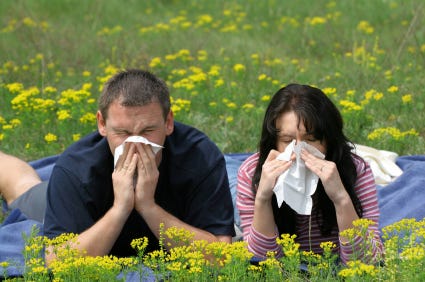Worms, Wheezes, and Weird Diseases
Another part of the adaptive immune system: IgE antibodies
When we talk about improving your immune system, it's crucial to understand its components. This knowledge will not only enhance your comprehension of the immune system but also shed light on how you can support its various functions, including the role of IgE antibodies in allergic conditions.
As I said previously, in medical school, we learned about the five types of antibodies (immunoglobulins) in the adaptive immune system. They are classified into IgG, IgM, IgA, IgD, and IgE. I learned them by memorizing the acronym G-A-M-E-D. They are distributed throughout the body, and each has a different function.
We’ve covered IgG and IgA antibodies. In case you missed those articles, you can find them (IgG) here and (IgA) here. This week, we’ll touch on IgE antibodies.
IgE Antibodies
Among the five immunoglobulins, immunoglobulin E (IgE) holds a pivotal role in allergic conditions. Discovered in 1968, IgE was the final immunoglobulin to be classified. Despite being the least abundant antibody class, with a normal concentration of 50-200 ng/ml in nonallergic individuals, IgE antibodies have a profound impact. They firmly attach to specific types of white blood cells, initiating the release of histamine from mast cells. This process can trigger reactions ranging from sneezing to hives to anaphylactic collapse and even death, underscoring the importance of understanding IgE in the context of allergies.
In the US, allergic reactions result in millions of hospital admissions and office visits each year, costing billions of dollars. Asthma and allergic diseases, such as allergic rhinitis (hay fever), food allergy, and eczema, are common for all age groups in the United States.
Asthma affects more than 24 million people in the U.S., including more than 4.6 million children. In 2021, the CDC’s National Center for Health Statistics reported that nearly 1 in 3 adults and more than 1 in 4 children have seasonal allergies, eczema, or food allergies, which tally to over 100 million people in the US alone. The worldwide prevalence of food allergy is estimated to be around 4% of children and 1% of adults, with an increased prevalence in the past two decades.
For the past few decades, allergies have increased significantly in Western countries. For instance, in the US there was a 75% increase in the prevalence of asthma from 1908 to 1994. The CDC reported a 50% increase in the prevalence of food allergies among children from 1997 to 2011. The US also reported a three-times increase in peanut or tree nut allergies between 1997 and 2008. (More on these allergies below.)
Asthma affects approximately 300 million people worldwide. It is a form of chronic lung inflammation. It usually presents with shortness of breath, cough, and wheezing. Allergic asthma, accounting for two-thirds of all asthma cases, is usually diagnosed by an elevated IgE level. During a process called cross-linking, an allergen is surrounded by the “arms” of the IgE antibody. This complex molecule then binds to the surface of specialized white blood cells - mast cells and basophils - releasing histamine, the first step of an inflammatory cascade leading to bronchospasm. This is the basis for what is commonly called an asthma attack.
Atopic dermatitis, known as eczema, is an inflammatory skin disorder characterized by dry and itchy lesions on the extremities, and the head and neck areas. Like other hypersensitivity reactions, the IgE antibody activates the release of pro-inflammatory mediators, leading to an inflammatory response in the skin, forming eczematous lesions.
The IgE-mediated reactions most commonly triggered are food allergies. The local or systemic symptoms begin minutes or hours after ingesting the offending food. The symptoms can range from mild (itchy mouth, a few hives) to severe (throat tightening, difficulty breathing).
More than 170 foods have been reported to cause allergic reactions. Nine food allergens – milk, egg, peanut, tree nuts, wheat, soy, fish, crustacean shellfish, and sesame – are responsible for almost all of the serious food allergy reactions in the United States. About 40 percent of children with food allergies are allergic to more than one food.
Association with vaccination
Here are a few references that connect increased IgE levels with vaccination, leading to allergies and anaphylaxis.
Highly increased levels of IgE antibodies to vaccine components in children with influenza vaccine-associated anaphylaxis (IVA): full text - The 2011-2012 IVA spike in Japan was caused by specific IgE antibodies to influenza vaccine components.
Inactivated influenza vaccine induces IgE antibody to the vaccine in preschool children: full text - Influenza vaccine induces IgE sensitization in young children, which may predispose vaccine-induced anaphylaxis.
Serum polyethylene glycol-specific IgE and IgG in patients with hypersensitivity to COVID-19 mRNA vaccines—full text—The results suggest that PEG is one of the antigens involved in allergy to COVID-19 mRNA vaccines. PEG-specific IgE and IgG may be useful in diagnosing allergy to COVID-19 mRNA vaccines.
Coming soon: Two new courses for Learning4You.org on PEG/Covid vaccines and Vaccines/allergies.
Vaccine components and allergic reactions
Virtually all vaccines have the potential to trigger anaphylaxis. The majority of acute-onset reactions are mediated by IgE antibodies against a vaccine component. Typically, these reactions occur within minutes of exposure to the relevant allergen, and most normally occur within 4 hours. Recently, Hypersensitivity reactions after vaccination are usually due to individual vaccine components. Here is a list of components known to be associated with allergies and IgE antibodies.
Microbial antigens: hypersensitivity to tetanus and diphtheria toxoids, pneumococcus, or Bordetella pertussis antigens)
Egg, chicken fibroblasts
Gelatin
Residual ingredients in the vaccine media – here is a list of excipients in the culture media
Milk - due to casein
Antibiotics
Adjuvants - aluminum hydroxide and aluminum phosphate
Preservatives - thimerosal, 2-phenoxyethanol, and phenol
Latex (in the stopper)
Gelatin
Quercetin helps reduce the symptoms of allergies, including runny noses, watery eyes, hives, and swelling of the face and lips.
IgG levels in the term infant are similar to maternal levels as due to transplacental transfer. However, IgE is not thought to pass through to the infant. Therefore, infants develop IgE in response to external stimuli. Some children with atopic diseases have plasma IgE antibody levels 5 to 20 times higher than normal.
Two potential allergies from vaccination are latex and gelatin.
The package insert of every human vaccine is required by the FDA to list all ingredients in the shot. In the past, nearly every vaccine used natural latex stoppers on the top of the vial. That meant by six months of age, an infant who had 19 injections would have had 19 exposures to latex. Over the years, most of the stoppers have been transitioned to inert butyl rubber (gray) stoppers. However, several vaccines still use latex stoppers. Here is a list, effective as of 2022, of vaccines that still retain natural latex in their vial stoppers.
Latex shares IgE epitopes with grasses and weed pollens, specifically mugwort, ragweed, timothy grass, and birch. These plants, common in temperate zones, produce a great deal of pollen. Children who react violently to pollen may have an underlying latex allergy. Latex has been documented to cross-react with papaya, mango, avocado, banana, chestnut, passion fruit, fig, melon, kiwi, pineapple, peach, tomato, grape, pear, apple, orange, chestnuts, and almonds.
Because legumes are from plants, there can occasionally be cross-reactivity between fruits and vegetables and legumes. Peanuts are a legume (in the same family as peas and lentils) and have proteins that are similar in structure to those in tree nuts.
People who are allergic to tree nuts, including almonds, Brazil nuts, walnuts, hazelnuts, macadamias, pistachios, pecans, and cashews can also be allergic to peanuts. Chestnuts don't contain the same proteins that cause allergic reactions to peanuts or tree nuts. So, if you are allergic to chestnuts that does not necessarily mean you will be allergic to tree nuts or peanuts, and vice versa.
Gelatin, which is sourced from cows and pigs, has been shown to cause allergic reactions and asthma in many children. There is a strong relationship between serious allergic reactions and the presence of specific IgE to gelatin. Anti-gelatin IgE levels in children with systemic immediate-type reactions including anaphylaxis to vaccines. Anaphylaxis to the measles, mumps, and rubella (MMR) vaccine has been reported and was found to be mediated by IgE to gelatin.
Vaccines that contain gelatin:
Varivax (children), Zostrix (adults)
Typhoid, Yellow fever, Rabies
Japanese Encephalitis
MMR, ProQuad, MMRV (MMR + Chickenpox)
Fluzone, FluMist
Worms, Wheezes, Weird Disease
Eosinophils are another type of white blood cell (WBC) involved in allergies. However, eosinophils play a much larger role than allergic responses. In med school, we learned that elevated eosinophil levels signified “worms, wheezes, and weird diseases.” Let’s explore what that means.
We have already discussed how elevated IgE, and now elevated eosinophils, can lead to asthma attacks (wheezes).
Parasites are classified as protozoans (single-cell parasites) or metazoans (multicell parasites). A parasitic infection can involve the gastrointestinal tract, the lungs, the bloodstream, or solid organs. Metazoans are referred to as helminths (worms). Elevated IgE levels occur in several types of helminthic infections and induce an antibody-dependent, cell-mediated attack against the helminths. After IgE binds to the parasite (worm), the complex binds to an eosinophil, causing the specialized WBC to release granules composed of proteins, cytokines, chemokines, enzymes, and growth factors that can either dislodge, damage, or kill the parasite. Therefore, it is common to observe both elevated IgE levels and eosinophilia in many helminthic parasitic infections. For our recommended parasite cleanse, go here.
Eosinophil counts over 450–500 cells/μl blood are considered mild eosinophilia and counts over 1,500 cells/μl are labeled as hyper-eosinophilia. Problems arising from immune dysregulation can also cause hyper-eosinophilia, including autoimmune diseases like inflammatory bowel disease, autoimmune myocarditis, vasculitis, and sarcoidosis. Elevated eosinophils can also be a sign of cancer such as leukemia, lymphoma, colorectal, and lung cancer. Although eosinophilia alone is not a sign of cancer, it is often suggestive of cancer if other causes have been eliminated. Considering the fact that parasites can be linked to cancer, it may be in the patient’s best interest to be treated for parasites before undergoing aggressive treatment for cancer.
Oddly enough, anxiety is associated with a common gut disorder called functional dyspepsia, which leads to chronic inflammation in the part of the small intestine called the duodenum. It is characterized by increased duodenal eosinophils.
Another weird disease associated with elevated eosinophils is eosinophilic esophagitis, now classified as a chronic disease of the immune system. Under normal conditions, the esophagus lacks eosinophils. When present, the condition is considered to be abnormal and part of an inflammatory process leading to chronically inflamed tissues that do not respond to medications given for gastroesophageal reflux disease (GERD). Food is difficult to swallow and often becomes lodged (impacted) in the lower esophagus leading to pain, vomiting, and persistent nausea. The diagnosis is most commonly made by a thorough history and a confirmatory upper GI with a biopsy. The first approach to therapy is dietary: Identify the specific food causing the reaction and eliminate it. If no specific allergenic food can be identified, a trial of the Six Food Elimination Diet (SFED) can be pursued, which eliminates cow's milk, wheat, peanut/tree nut, egg, soy, and seafood/shellfish for a minimum of six weeks with NO CHEATING (or you have to start the clock over again.)
At Tenpenny Integrative Medical Center, we use a technique we developed to eliminate sensitivities to food and environmental allergens we call SRT. You can read about it here – or you can make an appointment (scroll down). We have seen patients from all 50 states and nearly 20 countries to successfully be treated by SRT at our clinic. You can call for a FREE 15-minute consultation to see if SRT (or other therapies we offer) can help you.
A list of other “weird diseases” that can be associated with an elevated eosinophil count can be measured can be found here.










Chronic vitamin D starvation is the main factor in the rise of most of the conditions mentioned. Since the immune system “runs” on vitD it is not surprising the immune system malfunctions in vitD starved people.
I really appreciate this article. I have no allergies myself but know lots of people who do. Beginning to see that everything seems to come down to what we put in our bodies and how that harms us. I have never been interested in shots or conventional medicines thank goodness. I was brought up in a time when we ran barefoot and played in the woods all day. I appreciate now the fact that my parents could not afford to take us to the doctor so we did not become reliant on their "expertise". I don't even take aspirin which I account in part to my excellent health. Thanks for the lesson in immunology!